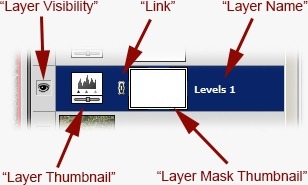
The material in this blogpost comes from:
• My Photoshop book called “Not Just Another Photoshop Book”
• And, my Small Group Workshop called “The Power of Layer Masks in Photoshop”
______________________
There is incredible power in being able to work on your image in Photoshop “globally” (the whole image), as well as “locally” (just part of your image). Being able to localize your image adjustments is the digital post-processing equivalent of the legendary Ansel Adams’ & Fred Archers’ photographic Zone System – see this post for more as it relates to Photoshop: https://blog.main.wattsdigital.com/using-zones-in-photoshop/
• This is Part 1 of what will be a multi-part series of blogposts on Layer Masks. Each post will be short and sweet, and focused on just one aspect of Layer Masks – given in bite-size pieces, if you will.
• For Part 2, see the link near the bottom …
So, what’s a Layer Mask, and why do I need it?
• Layer Masks give you the ability to make adjustments to your image locally, not just globally, by hiding or revealing portions of your adjustment – you can pinpoint specific areas to change.
• What “adjustments” can you localize? Virtually anything you can do in Photoshop, such as contrast, color, brightness, sharpness, etc.
• You don’t visually “see” a Layer Mask in your final output, only the results – it’s invisible, and works in the background.
___________
Part 1: Let’s focus on one key component in working with Layer Masks – – Adjustment Layers
You’ll work with Layer Masks through Adjustment Layers, such as the Levels or Hue Saturation Adjustment layers (discussed extensively in my Book & Meetups).
Think of Adjustment Layers as “clear plastic overlays” that are stacked and sandwiched on top of your original image, with each Layer giving you the “global” or “local” ability to control an adjustment to your image. They’re depicted two-dimensionally in the Layers Panel (see the pic and more below).

Local vs Global Adjustments
One of the main purposes of Adjustment Layers is to allow you to make adjustments to your image, both globally and locally, basically in a non-destructive manner. This is one of the more powerful features in Photoshop. By the way, “destructive” is defined as causing pixelization and posterization to your digital image, resulting in loss of critical information.
In addition to “global” control, you can define what areas to “localize” by shaping your Layer Mask Thumbnail (part of an adjustment layer, see below) using Selections, such as the Magic Wand Tool, Brush Tool, etc (discussed in future blogposts).
So, what’s in an adjustment layer?

• Layer Visibility (this turns the Layer on & off)
• Adjustment Icon (Levels adjustment layer shown below)
• Link (generally, leave this alone)
• Layer Mask Thumbnail (white by default)
• Layer Name (double click to change, if desired)
Key Points
• Keep in mind: you don’t visually “see” a Layer Mask in your final output, only the results – and the Layer Mask Thumbnail is one of the ways where you can both “see” & “shape” the Layer Mask in Photoshop.
When you see the color BLACK in a Layer Mask Thumbnail, it “hides” the effects of the Adjustment Layer – conversely, the color WHITE “reveals” the effects of the Adjustment Layer (this point will make more sense later).
Where to Find:
You work with adjustment layers in the Layers Panel (discussed extensively in my Book & Meetups). If you set your workspace up as suggested in my blogpost here (with video), then your Layers Panel will be near the bottom right-hand corner of your workspace.

The Layers Panel is where you’ll manage all of your Layers, including Adjustment Layers. Think of this as a 2-dimensional side-view of your original image (the Background Layer), with your layers (“clear plastic overlays”) stacked & sandwiched on top of it.
In the image to the right are examples of Adjustment Layers that you’ll use regularly, as shown in the Layers Panel, with no “shaping” of a Layer Mask (remember, “white reveals, black hides”)

To create an Adjustment Layer (in your Layers Panel)
– – 2 ways:
• Click on the “New Adjustment Layer” button at the bottom of the Layers Panel (the faux Yin-Yang” button), and choose the desired adjustment from the drop-down list.
• You can also go to the Adjustments Panel (one of my recommended Workspace Panels, shown here, with video) and choose your desired Adjustment Layer from the icons – see the pic to the right.
____________
In the next Quick Tip in this series: Layer Mask Concepts & Basics, Part 2 – Two Critical Workspace Panels for working with Layer Masks: https://blog.main.wattsdigital.com/photoshop-layer-mask-concepts-basics-part-2/
And don’t forget: the material in this blogpost is from one of my Small Group Workshops called “The Power of Layer Masks in Photoshop” – they’re live, online & available nationwide:
https://wattsdigital.com/small-group-workshops
____________
• AVAILABLE NATIONWIDE – for more on my free live & online Photoshop Meetups, click here:
https://wattsdigital.com/free-live-meetups-online
• More Photoshop videos at my YouTube Channel:
https://www.youtube.com/user/wattsdigitalvideos
• Was this information helpful?
Sign up for my free monthly newsletter here …
• By the way, this is all based on my Photoshop book designed for photographers, “Not just another Photoshop Book”, available as eBook (immediate PDF download) or paperback from Amazon:
https://wattsdigital.com/photoshop-book-e-book
Questions? Please contact me – also, feel free to comment and forward this to your photography friends!
Thx again, and cheers,
John Watts ?
